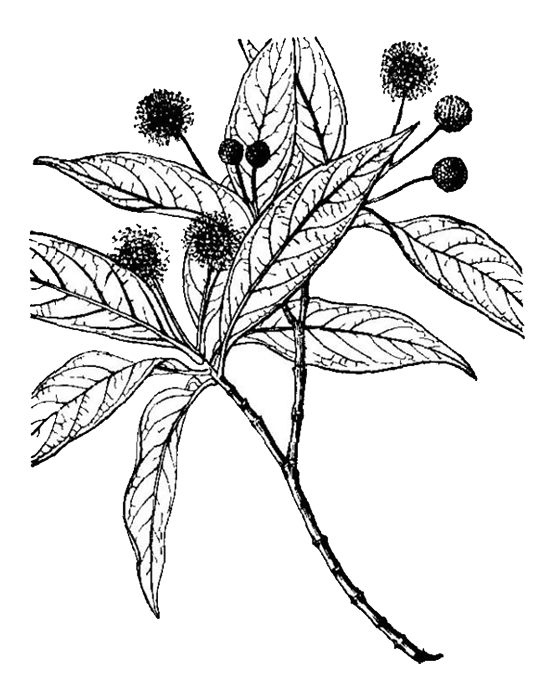 Gen info Gen info
- Some compilations list Metadina as the sole species in the monotypic genus Metadina in the family Rubiaceae. It was first described by Heinrich Zollinger and Alexander Moritzi, with its current name by Reinier Bakhuizen van den Brink.
- Plants of the World Online list it as a synonym of Adina trichotoma.
Botany
Metadina trichotoma is a tree, apparently evergreen, flowering at 5-10 m tall; branches compressed becoming terete, brown to gray, puberulent to glabrous, usually densely lenticellate with elliptic white raised lenticels. Petiole 3-10 mm, glabrous; leaf blade drying stiffly papery to subleathery, lanceolate, elliptic-lanceolate, or ovate-oblong, 6-20 × 2-7 cm, adaxially glabrous and rather shiny, abaxially glabrous to puberulent or tomentulose at least along veins, base acute to obtuse, apex acute to caudate-acuminate; secondary veins 8-12 pairs, sometimes with small pilosulous domatia in axils; stipules deltoid to narrowly triangular, 5-8 mm, acute to perhaps obtuse. Inflorescence glabrous to densely puberulent or tomentulose; peduncles 1.5-3 cm, usually articulate and with 4 caducous bracts 1-3 mm near middle; flowering heads 6-7 mm in diam. across calyces, ca. 12 mm in diam. across corollas; bracteoles ca. 2 mm. Calyx with ovary portion obconic, 0.5-1 mm, pilosulous to glabrescent, surrounded at base by a ring of pilose trichomes ca. 0.5 mm; limb lobed essentially to base; lobes 1-2 mm, narrowly elliptic-oblong, obtuse. Corolla outside glabrous; tube 3-3.5 mm; lobes triangular-spatulate, ca. 1 mm. Stigmas obconic, ca. 1 mm, exserted for ca. 5 mm. Fruiting head 8-10 mm in diam. Capsules obovoid to obconic, ca. 1.5 mm, pilosulous at least on apical portion. (Flora of China) (2)
Distribution
- Native to the Philippines.
- Also native to Assam, Bangladesh, Borneo, Cambodia, China, Jawa, Laos, Malaya, Maluku, Myanmar, New Guinea, Sulawesi, Sumatera, Thailand, Vietnam.
(1)
- Grows primarily in wet tropical biome.
- Forests at streamsides, 300-1400 m.
 Constituents Constituents
- Phytochemical screening of 80% ethanol extract yielded alkaloid, terpenoid, glycoside, and anthraquinone, with absence of flavonoid, tannin, and saponin. (see study below) (3)
- Study of bark of Metadina trichotoma isolated two new 27-nor-triterpene glycosides, Metatrichoside A (1), metatrichoside B (2), together with pyrocincholic acid 3β -O-β -D-quinovopyran-osyl-28-O-β -D-glucopyranoside (3), pyrocincholic acid 3β -O-β -D-quinovopyranosyl-28-O-β -D-glucopyranosyl-(1→6)-β -D-glucopyranoside (4), quinovic acid 3β -O-β -D-quinovopyranoside (5), quinovic acid 3β -O-β -D-quinovopyranosyl-28-O-β -D-glucopyranoside (6), quinovic acid 3β -O-β -D-glucopyranoside (7) and quinovic acid 3β -O-β -D-glucopyranosyl-28-O-β -D-glucopyranoside (8). (see study below) (6)
- Study isolated one new triterpene, nine known compounds, pyrocincholic acid 3ß-O-ß-D-quinovopyranosyl-28-O-ß-D-glucopyranoside (2), quinovic acid (3), berchemolide (4), syringaresinol-O-ß-D-glucopyroside (5), E-palmityl-4-hydroxycinnamic acid (6), deacetylasperulosidic acid methyl ester (7), 6-O-methyldeacetylasperulosidic acid methyl ester (8), geniposide (9), and scoponin (10) . (see study below) (7)
Properties
- Study has suggest antidiabetic, α-glucosidase inhibitory, glucose uptake, cathepsin B inhibitory, antiobesity, antihyperlipidemic properties.
Parts used
Leaves, aerial parts.
Uses
Folkloric
- No reported folkloric medicinal use in the Philippines.
-
In Indonesia and Thailand, bark preparations used as tonic.
Others
- Wood: Yield as heavy, hard, durable wood. Heartwood yellow, yellow-brown to orange-red. Used for house building, planks, flooring, fence posts, joinery, turnery, tool handles, and agricultural implements. Serviceable as freshwater piles for 5-15 years, 8-10 years as ground poles, 15r years for boats, 60 years or long for construction under cover.
Studies
• α-Glucosidase Inhibitory Activity / Antidiabetic: In type 2 diabetes mellitus, inhibition of α-glucosidase is a treatment target to delay absorption of glucose after meals. Study evaluated the α-glucosidase inhibitory activity of 80% ethanol extracts of leaves and twigs of plants from the Apocynaceae, Clusiaseae, Euphorbiaceae, and Rubiaceae. Thirty-seven of 45 samples were showed to be more potent α-glucosidase inhibitors with IC50s ranging from 2.33-112.02 µg/mL compared to control acarbose with IC50 117.20 µg/mL. Adina trichotoma showed IC50 of 28.22 µg/mL. (see constituents above) (3)
• Cytotoxicity / A549 Non-Small Cell Lung Cancer Cell Line / Bark: Study of bark of Metadina trichotoma isolated two new 27-nor-triterpene glycosides, metatrichoside A (1), metatrichoside B (2), together six other compounds. Compound 5 and 6 showed cytotoxic activities towards A549 non-small cell lug cancer cell line (IC50s 8.43 and 6.06 µm) and the methanol extract inhibited the activity of cathepsin B with IC50 of 0.77 µg/mL. (see constituents above) (6)
• Glucose Uptake Activity: Study of Metadina trichotoma isolated one new triterpene,
6α-hydroxyilexosapogenin A (1) and nine known compounds. By glucose concentration assay, compound 2 (pyrocincholic acid 3ß-O-ß-D-quinovopyranosyl-28-O-ß-D-glucopyranoside) was found to stimulate glucose uptake in 3T3-L1 adipocytes, the first pyrocincholic acid type triterpenoid that promotes glucose uptake activity. (see constituents above) (7)
• PAQG (Saponin) / Suppression of Adipogenesis / Antiobesity / Hypolipidemic: Study evaluated the effect of pyrocincholic acid 3β-O-β-D-quinovopyranosyl-28-O-β-D-glucopyranoside (PAQG), a 27-nor-oleanolic acid saponin extracted from Metadina trichotoma, on adipogenesis and lipid metabolism in 3T3-L1 adipocytes. PAQC significantly reduced the adipogenesis, adiponectin secretion, and expression level of key transcription factors related to adipogenesis, such as PPARγ, C/EBPβ, C/EBPα, and FABP4, and also increased levels of FFA and glycerol and reduced TG level in mature adipocytes. Results showed PAQG inhibits differentiation and regulates lipid metabolism of 3T3-L1 cells via AMPK pathway, suggesting potential as a novel natural product for treatment of obesity and hyperlipidemia. (8)
Availability
Wild-crafted. |

![]()





